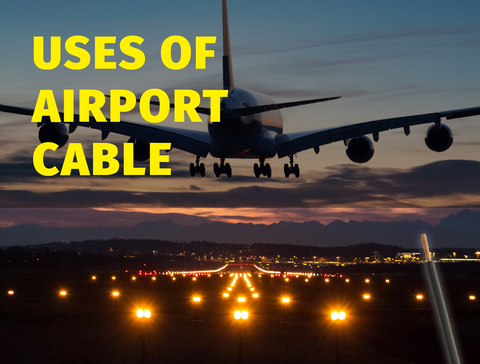Types of Airport Cable And Its Applications
Airports require specific types of cables to ensure safe operations. Types of wires used in airports include airfield lighting cables, terminal building cables, ground power unit cables, and many others. Lighting cables are some of the most essential in airport operations.
Airport lighting wires are appropriate for many different installations, including conduit, ducts, or direct burial. Because they are used in airports, lighting cables are supposed to be extra-efficient. It is also expected of them not to require maintenance for at least five years after the start of operations.

Cables can have both metallic and non-metallic conduits. They are designed for a variety of airport applications, including airport lighting systems, lighting circuits, control circuits, and airport control equipment.
All airport cables are resistant to sunlight, which is an essential characteristic given the specifications of their use. They are also known to have an optimal balance of electrical and mechanical features that guarantee a prolonged cable life. These cables have a single conductor made of fully annealed stranded bare copper that ranges from 12 AWG to 4 AWG. Conductors have Class B stranding Per ASTM B 8 and are resistant to heat, which is necessary because prolonged use may cause the cables to overheat.
Types of Airport Cables
Airfield Lighting Cables
Airfield lighting cables are used in airport lighting systems, lighting circuits, control circuits, and airport control equipment. Lighting wires are suitable for runways, taxiways, navigational aids, control systems, and obstruction lighting, including LED and Xenon. They can be used for different conduit, duct, aerial, raceway, and direct burial applications. On runways, lighting cables play a crucial role as they ensure night visibility for pilots. They also help pilots to determine where exactly they are located on the airfield. Moreover, pilots need light to see the runway in front of them.
Terminal Building Cables
Airport terminal building cables are used in passenger terminals and escalators. Because of the resistance to fire, they are frequently used in fire suppression systems and a variety of applications inside the airport's building.
Aircraft Ground Power Unit Cables
Aircraft ground power cables are GPU wires used in ground power units so that the aircraft can function properly while being stationed. These cables are both energy-efficient and flexible. GPUs provide 400Hz power needed for the normal functioning of the cables.
Signaling, Control, and Power Supply Cables
Signaling, control, and power supply cables are used in x-rays, sensors, and conveyor belts. They are fire-retardant for the sake of protecting employees and passengers from incidents that involve smoke and corrosive gases.
Installations
Wires are insulated with black Cross-Linked Polyethylene (XLPE) that has a semi-conductive stress control level. XLPE insulations make these cables resistant to track, abrasion, moisture, fluid chemicals, and heat. This material decreases short circuit and overload levels.
Wires are available in either 600 volts or 5000 volts constructions and are approved for direct burial. 5kv versions are used in the primary circuits in between the constant current source. Lower-rate lighting cables of 600 volts are suitable for secondary circuits where durability is not so critical.
Cables are used for direct burial under the airport runways. Places with direct buried circuits and the locations of cable connections are identified by distinctive marks according to standards. Wires used for direct burial are rugged as a precautionary measure.
Most often, cables are buried in ducts to feed series lights and navigational (LEDs). When used in conduits or ducts, wires should have no connections or splices. A semi-conducting tape should be helically applied over the insulation because the atmosphere in the ducts can be quite humid. Shielding helps to prevent airport accidents by ensuring that the loss of power is kept at a minimum. It also helps to improve the durability of the equipment. The lowest possible ducts should be the first ones to receive the wires. Duct routes should also be located as low as possible without any interference for the most effective use. Duct banks and conduits are installed separately according to the standards.
The temperature range of airport cables varies from 90°C in day-to-day operations to 130°C in emergency cases and 250°C in short circuit applications when exposed to the extreme heat. Some of the industry standards met by airport wires include ICEA S-66-524, FAA-L-824, and RoHS.
Types of Airport Cables Offered
The L284 type C cable offered by Nassau National Cable is explicitly designed for airway lighting systems. Its characteristics minimize the potential impact of heat. Cable's default length is 5000ft/ real, but other measures are available upon request.
Alternative versions of wires with tinned copper, shielding, and different colors are also available upon request. Airport Lighting Cable 5kv and Airport Lighting Cable 600V sold by Nassau National Cable are exclusively manufactured in the United States, which ensures their highest quality.


















